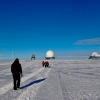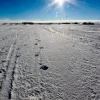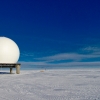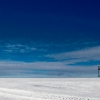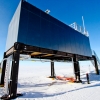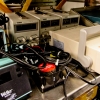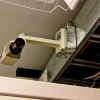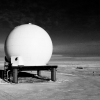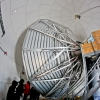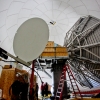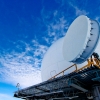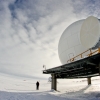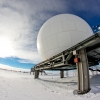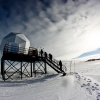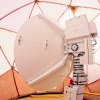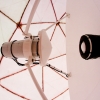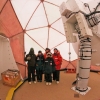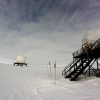CHAPTER 25
When you are at the South Pole, communicating with the outside world can be a tricky business. You can call, or send an email of course, but because the Pole is so remote, both of these depend on communication satellites, which for us at the bottom of the world, are fickle at best.
Most communications satellites these days are positioned in geosynchronous orbit- meaning they are positioned over the equator and orbit at the same speed that the Earth is rotating, thereby maintaining their relative position over a fixed spot on the Earth’s surface. The reason for this is so that the satellite dish on the ground can remain pointed at the same spot in the sky- think of that ugly Direct TV dish on the side of your house. Were the satellite in a non-geosynchronous orbit, the ground dish would have to track the satellite as it moved across the sky, making things far more complicated, for the TV company and the naive consumer.
Well, at the South Pole it is more complicated. Even though these geosynchronous satellites are orbiting very far from Earth and above the equator, at the Pole they are actually still below the horizon and we can’t see them with a direct line of sight. How then do we use them? Well, luckily for us, some of the older satellites have run out of fuel, and they aren’t able to make the slight course corrections needed to stay in perfect geosynchronous orbit. When this happens, their orbit starts to “wobble” and the satellite will end up oscillating back and forth across the equator as it continues its journey around the Earth- you can think of it like a horse on a carrousel going up and down as the carrousel turns. Every time the satellite oscillates south of the equator it will come into view at the South Pole, just over the horizon. But when it oscillates back north, it will be lost from view until the next cycle.
What this means for anybody wanting to call or email home from the Pole is that they’ll only be able to do it during a fairly short window when the satellite is in view, over the horizon. The duration of this window depends on how “wobbly” the satellite’s orbit is, but typically it was for only a few hours. Fortunately there are a few of these out-of-fuel satellites running around up there, all coming into view at different times, so combined they were able to offer coverage for a good chunk of the day, say 10 or 12 hours total. But, to confound things further, the times that these satellites were in view would shift a few minutes every day due a difference between the normal solar day (24hrs) and the sidereal day (23hrs and 56min- the time the Earth rotates a full 360 degrees). So, when we first got to the Pole in November, a particular satellite might have been up at a convenient 10am to 12pm, but by the time we left in February, that window would have shifted to 2am to 4am. As much as we loved calling home, sometimes that was a little too early to rouse Kacey out of our warm bed for a phone date!
To avoid interfering with science experiments at the South Pole, the satellite communication dishes were situated far from anything else on station- past summer camp, past the berms (the huge outside storage area), almost all the way to the end of the skiway. The dishes, there are 3 or 4 of them- one for every satellite being used- sit inside a pair of elevated radomes, that coincidentally look like two giant white golf balls, thus what they are called by everyone at the South Pole.
One of the eccentric communications engineers, Chris, casually offered to give us a tour of the golf balls one day while he was handing his dishes to us through the dishpit window, and was totally taken aback by our eager enthusiasm to take him up on the idea. The golf balls are a restricted area, and we had been jonesing to find out what was so secretive going on inside those mysterious big white domes ever since we had arrived. Word of our upcoming “secret” tour spread rapidly through the kitchen staff, and by the time the day arrived there were five of us dressed and nonchalantly waiting to meet Chris for the long walk out to the golf balls.
Our tour coincided with a communications down time, when no satellites were in view, so we were able to climb the stairs and enter each of the futuristic looking radomes. Stepping inside the first giant geodesic dome I was expecting to be confronted by some sort of James Bond-esk lair, full of maniacal machines resolutely churning away in their devious endeavors. What I saw though, was just a big satellite dish, composedly pointed at the horizon. No whirling machinery, no lasers, no pits full of piranhas- nope, just an oversized Direct TV dish. Not even the giant white shell of the golf ball was conspiratorial in purpose. It turns out that the shell is just there to provide protection from the weather for the satellite dish inside and is made of a sturdy plastic that doesn’t interfere with the radio transmissions. Well, so much for the heightened security and restricted access- it was all in place just to keep us safe- apparently you could become fried like a bucket of KFC if you wander in front of an active satellite dish, but I think Chris might have been exaggerating this little fact just to placate my obvious disappointment from the lack of top secret activities taking place out at the golf balls.
Prev ChapterNext Chapter


